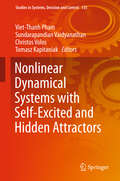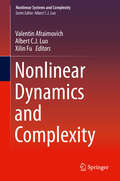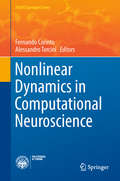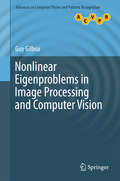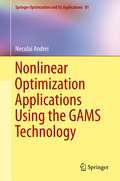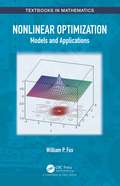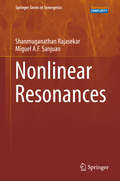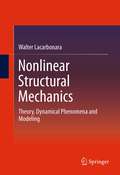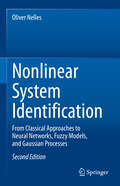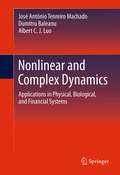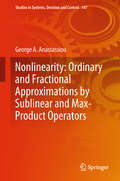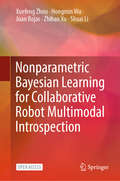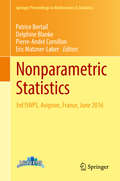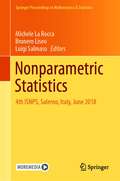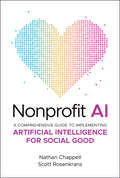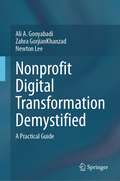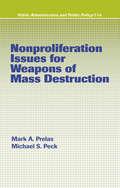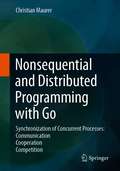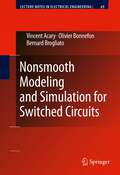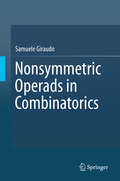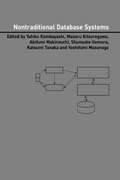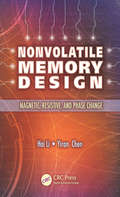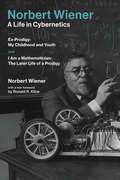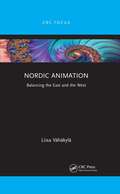- Table View
- List View
Nonlinear Dynamical Systems with Self-Excited and Hidden Attractors (Studies In Systems, Decision And Control #133)
by Sundarapandian Vaidyanathan Christos Volos Viet-Thanh Pham Tomasz KapitaniakThis book highlights the latest findings on nonlinear dynamical systems including two types of attractors: self-excited and hidden attractors. Further, it presents both theoretical and practical approaches to investigating nonlinear dynamical systems with self-excited and hidden attractors. The book includes 20 chapters contributed by respected experts, which focus on various applications such as biological systems, memristor-based systems, fractional-order systems, finance systems, business cycles, oscillators, coupled systems, hyperchaotic systems, flexible robot manipulators, electronic circuits, and control models. Special attention is given to modeling, design, circuit realization, and practical applications to address recent research problems in nonlinear dynamical systems.The book provides a valuable reference guide to nonlinear dynamical systems for engineers, researchers, and graduate students, especially those whose work involves mechanics, electrical engineering, and control systems.
Nonlinear Dynamics and Complexity
by Valentin Afraimovich Albert C. J. Luo Xilin FuThis important collection presents recent advances in nonlinear dynamics including analytical solutions, chaos in Hamiltonian systems, time-delay, uncertainty, and bio-network dynamics. Nonlinear Dynamics and Complexity equips readers to appreciate this increasingly main-stream approach to understanding complex phenomena in nonlinear systems as they are examined in a broad array of disciplines. The book facilitates a better understanding of the mechanisms and phenomena in nonlinear dynamics and develops the corresponding mathematical theory to apply nonlinear design to practical engineering.
Nonlinear Dynamics in Computational Neuroscience (PoliTO Springer Series)
by Fernando Corinto Alessandro TorciniThis book provides an essential overview of computational neuroscience. It addresses a broad range of aspects, from physiology to nonlinear dynamical approaches to understanding neural computation, and from the simulation of brain circuits to the development of engineering devices and platforms for neuromorphic computation. Written by leading experts in such diverse fields as neuroscience, physics, psychology, neural engineering, cognitive science and applied mathematics, the book reflects the remarkable advances that have been made in the field of computational neuroscience, an emerging discipline devoted to the study of brain functions in terms of the information-processing properties of the structures forming the nervous system. The contents build on the workshop “Nonlinear Dynamics in Computational Neuroscience: from Physics and Biology to ICT,” which was held in Torino, Italy in September 2015.
Nonlinear Eigenproblems in Image Processing and Computer Vision (Advances in Computer Vision and Pattern Recognition)
by Guy GilboaThis unique text/reference presents a fresh look at nonlinear processing through nonlinear eigenvalue analysis, highlighting how one-homogeneous convex functionals can induce nonlinear operators that can be analyzed within an eigenvalue framework. The text opens with an introduction to the mathematical background, together with a summary of classical variational algorithms for vision. This is followed by a focus on the foundations and applications of the new multi-scale representation based on non-linear eigenproblems. The book then concludes with a discussion of new numerical techniques for finding nonlinear eigenfunctions, and promising research directions beyond the convex case.Topics and features: introduces the classical Fourier transform and its associated operator and energy, and asks how these concepts can be generalized in the nonlinear case; reviews the basic mathematical notion, briefly outlining the use of variational and flow-based methods to solve image-processing and computer vision algorithms; describes the properties of the total variation (TV) functional, and how the concept of nonlinear eigenfunctions relate to convex functionals; provides a spectral framework for one-homogeneous functionals, and applies this framework for denoising, texture processing and image fusion; proposes novel ways to solve the nonlinear eigenvalue problem using special flows that converge to eigenfunctions; examines graph-based and nonlocal methods, for which a TV eigenvalue analysis gives rise to strong segmentation, clustering and classification algorithms; presents an approach to generalizing the nonlinear spectral concept beyond the convex case, based on pixel decay analysis; discusses relations to other branches of image processing, such as wavelets and dictionary based methods.This original work offers fascinating new insights into established signal processing techniques, integrating deep mathematical concepts from a range of different fields, which will be of great interest to all researchers involved with image processing and computer vision applications, as well as computations for more general scientific problems.
Nonlinear Optimization Applications Using the GAMS Technology
by Neculai AndreiHere is a collection of nonlinear optimization applications from the real world, expressed in the General Algebraic Modeling System (GAMS). The concepts are presented so that the reader can quickly modify and update them to represent real-world situations.
Nonlinear Optimization: Models and Applications (Textbooks in Mathematics)
by William P. FoxOptimization is the act of obtaining the "best" result under given circumstances. In design, construction, and maintenance of any engineering system, engineers must make technological and managerial decisions to minimize either the effort or cost required or to maximize benefits. There is no single method available for solving all optimization problems efficiently. Several optimization methods have been developed for different types of problems. The optimum-seeking methods are mathematical programming techniques (specifically, nonlinear programming techniques). Nonlinear Optimization: Models and Applications presents the concepts in several ways to foster understanding. Geometric interpretation: is used to re-enforce the concepts and to foster understanding of the mathematical procedures. The student sees that many problems can be analyzed, and approximate solutions found before analytical solutions techniques are applied. Numerical approximations: early on, the student is exposed to numerical techniques. These numerical procedures are algorithmic and iterative. Worksheets are provided in Excel, MATLAB®, and Maple™ to facilitate the procedure. Algorithms: all algorithms are provided with a step-by-step format. Examples follow the summary to illustrate its use and application. Nonlinear Optimization: Models and Applications: Emphasizes process and interpretation throughout Presents a general classification of optimization problems Addresses situations that lead to models illustrating many types of optimization problems Emphasizes model formulations Addresses a special class of problems that can be solved using only elementary calculus Emphasizes model solution and model sensitivity analysis About the author: William P. Fox is an emeritus professor in the Department of Defense Analysis at the Naval Postgraduate School. He received his Ph.D. at Clemson University and has taught at the United States Military Academy and at Francis Marion University where he was the chair of mathematics. He has written many publications including over 20 books, and over 150 journal articles. Currently, he is an adjunct professor in the Department of Mathematics at the College of William and Mary. He is the emeritus director of both the High School Mathematical Contest in Modeling and the Mathematical Contest in Modeling.
Nonlinear Resonances
by Shanmuganathan Rajasekar Miguel A.F. SanjuanThis introductory text presents the basic aspects and most important features of various types of resonances and anti-resonances in dynamical systems. In particular, for each resonance, it covers the theoretical concepts, illustrates them with case studies, and reviews the available information on mechanisms, characterization, numerical simulations, experimental realizations, possible quantum analogues, applications and significant advances made over the years. Resonances are one of the most fundamental phenomena exhibited by nonlinear systems and refer to specific realizations of maximum response of a system due to the ability of that system to store and transfer energy received from an external forcing source. Resonances are of particular importance in physical, engineering and biological systems - they can prove to be advantageous in many applications, while leading to instability and even disasters in others. The book is self-contained, providing the details of mathematical derivations and techniques involved in numerical simulations. Though primarily intended for graduate students, it can also be considered a reference book for any researcher interested in the dynamics of resonant phenomena.
Nonlinear Structural Mechanics
by Walter LacarbonaraThis book reviews the theoretical framework of nonlinear mechanics, covering computational methods, applications, parametric investigations of nonlinear phenomena and mechanical interpretation towards design. Builds skills via increasing levels of complexity.
Nonlinear System Identification: From Classical Approaches to Neural Networks, Fuzzy Models, and Gaussian Processes
by Oliver NellesThis book provides engineers and scientists in academia and industry with a thorough understanding of the underlying principles of nonlinear system identification. It equips them to apply the models and methods discussed to real problems with confidence, while also making them aware of potential difficulties that may arise in practice. Moreover, the book is self-contained, requiring only a basic grasp of matrix algebra, signals and systems, and statistics. Accordingly, it can also serve as an introduction to linear system identification, and provides a practical overview of the major optimization methods used in engineering. The focus is on gaining an intuitive understanding of the subject and the practical application of the techniques discussed. The book is not written in a theorem/proof style; instead, the mathematics is kept to a minimum, and the ideas covered are illustrated with numerous figures, examples, and real-world applications. In the past, nonlinear system identification was a field characterized by a variety of ad-hoc approaches, each applicable only to a very limited class of systems. With the advent of neural networks, fuzzy models, Gaussian process models, and modern structure optimization techniques, a much broader class of systems can now be handled. Although one major aspect of nonlinear systems is that virtually every one is unique, tools have since been developed that allow each approach to be applied to a wide variety of systems.
Nonlinear Time Series Analysis
by Holger Kantz Thomas SchreiberThe paradigm of deterministic chaos has influenced thinking in many fields of science. Chaotic systems show rich and surprising mathematical structures. In the applied sciences, deterministic chaos provides a striking explanation for irregular behaviour and anomalies in systems which do not seem to be inherently stochastic. The most direct link between chaos theory and the real world is the analysis of time series from real systems in terms of nonlinear dynamics. Experimental technique and data analysis have seen such dramatic progress that, by now, most fundamental properties of nonlinear dynamical systems have been observed in the laboratory. Great efforts are being made to exploit ideas from chaos theory wherever the data displays more structure than can be captured by traditional methods. Problems of this kind are typical in biology and physiology but also in geophysics, economics, and many other sciences.
Nonlinear and Complex Dynamics
by Albert C. Luo José António Machado Dumitru BaleanuNonlinear Dynamics of Complex Systems describes chaos, fractal and stochasticities within celestial mechanics, financial systems and biochemical systems. Part I discusses methods and applications in celestial systems and new results in such areas as low energy impact dynamics, low-thrust planar trajectories to the moon and earth-to-halo transfers in the sun, earth and moon. Part II presents the dynamics of complex systems including bio-systems, neural systems, chemical systems and hydro-dynamical systems. Finally, Part III covers economic and financial systems including market uncertainty, inflation, economic activity and foreign competition and the role of nonlinear dynamics in each.
Nonlinearity: Ordinary and Fractional Approximations by Sublinear and Max-Product Operators (Studies In Systems, Decision And Control #147)
by George A. AnastassiouThis book focuses on approximations under the presence of ordinary and fractional smoothness, presenting both the univariate and multivariate cases. It also explores approximations under convexity and a new trend in approximation theory –approximation by sublinear operators with applications to max-product operators, which are nonlinear and rational providing very fast and flexible approximations. The results presented have applications in numerous areas of pure and applied mathematics, especially in approximation theory and numerical analysis in both ordinary and fractional senses. As such this book is suitable for researchers, graduate students, and seminars of the above disciplines, and is a must for all science and engineering libraries.
Nonparametric Bayesian Learning for Collaborative Robot Multimodal Introspection
by Shuai Li Xuefeng Zhou Zhihao Xu Hongmin Wu Juan RojasThis open access book focuses on robot introspection, which has a direct impact on physical human–robot interaction and long-term autonomy, and which can benefit from autonomous anomaly monitoring and diagnosis, as well as anomaly recovery strategies. In robotics, the ability to reason, solve their own anomalies and proactively enrich owned knowledge is a direct way to improve autonomous behaviors. To this end, the authors start by considering the underlying pattern of multimodal observation during robot manipulation, which can effectively be modeled as a parametric hidden Markov model (HMM). They then adopt a nonparametric Bayesian approach in defining a prior using the hierarchical Dirichlet process (HDP) on the standard HMM parameters, known as the Hierarchical Dirichlet Process Hidden Markov Model (HDP-HMM). The HDP-HMM can examine an HMM with an unbounded number of possible states and allows flexibility in the complexity of the learned model and the development of reliable and scalable variational inference methods.This book is a valuable reference resource for researchers and designers in the field of robot learning and multimodal perception, as well as for senior undergraduate and graduate university students.
Nonparametric Statistics: 3rd ISNPS, Avignon, France, June 2016 (Springer Proceedings in Mathematics & Statistics #250)
by Patrice Bertail Delphine Blanke Pierre-André Cornillon Eric Matzner-LøberThis volume presents the latest advances and trends in nonparametric statistics, and gathers selected and peer-reviewed contributions from the 3rd Conference of the International Society for Nonparametric Statistics (ISNPS), held in Avignon, France on June 11-16, 2016. It covers a broad range of nonparametric statistical methods, from density estimation, survey sampling, resampling methods, kernel methods and extreme values, to statistical learning and classification, both in the standard i.i.d. case and for dependent data, including big data. The International Society for Nonparametric Statistics is uniquely global, and its international conferences are intended to foster the exchange of ideas and the latest advances among researchers from around the world, in cooperation with established statistical societies such as the Institute of Mathematical Statistics, the Bernoulli Society and the International Statistical Institute. The 3rd ISNPS conference in Avignon attracted more than 400 researchers from around the globe, and contributed to the further development and dissemination of nonparametric statistics knowledge.
Nonparametric Statistics: 4th ISNPS, Salerno, Italy, June 2018 (Springer Proceedings in Mathematics & Statistics #339)
by Luigi Salmaso Michele La Rocca Brunero LiseoHighlighting the latest advances in nonparametric and semiparametric statistics, this book gathers selected peer-reviewed contributions presented at the 4th Conference of the International Society for Nonparametric Statistics (ISNPS), held in Salerno, Italy, on June 11-15, 2018. It covers theory, methodology, applications and computational aspects, addressing topics such as nonparametric curve estimation, regression smoothing, models for time series and more generally dependent data, varying coefficient models, symmetry testing, robust estimation, and rank-based methods for factorial design. It also discusses nonparametric and permutation solutions for several different types of data, including ordinal data, spatial data, survival data and the joint modeling of both longitudinal and time-to-event data, permutation and resampling techniques, and practical applications of nonparametric statistics.The International Society for Nonparametric Statistics is a unique global organization, and its international conferences are intended to foster the exchange of ideas and the latest advances and trends among researchers from around the world and to develop and disseminate nonparametric statistics knowledge. The ISNPS 2018 conference in Salerno was organized with the support of the American Statistical Association, the Institute of Mathematical Statistics, the Bernoulli Society for Mathematical Statistics and Probability, the Journal of Nonparametric Statistics and the University of Salerno.
Nonprofit AI: A Comprehensive Guide to Implementing Artificial Intelligence for Social Good
by Nathan Chappell Scott RosenkransA hands-on roadmap to implement Artificial Intelligence in your nonprofit organization You've probably done everything in life that you were told to do: get educated, secure a job, work hard and be careful with money. And where did that lead you? Straight to the middle! But weren't you made for more? In Nonprofit AI: A Comprehensive Guide to Implementing Artificial Intelligence for Social Good, a team of veteran artificial intelligence (AI) experts from the nonprofit sector delivers an insightful and practical overview of how purpose-driven organizations can use AI to increase their impact and advance their missions. The authors offer an all-encompassing guide to understanding the promise and peril of implementing AI in the nonprofit sector, addressing both the theoretical and hands-on aspects of this necessary transformation. The book provides you with case studies, practical tools, ethical frameworks and templates you can use to address the challenges of AI adoption – including ethical limitations – head-on. It draws on the authors' thirty years of combined experience in the nonprofit industry to help you equip your nonprofit stakeholders with the knowledge and tools they need to successfully navigate the AI revolution. You'll also find: Innovative and proven approaches to responsible and beneficial AI implementation taken by real-world organizations that will inspire and guide you as you move forward Strategic planning, project management, and data governance templates and resources you can use immediately in your own nonprofit Information on available AI training programs and resources to build AI fluency and capacity within nonprofit organizations. Best practices for ensuring AI systems are transparent, accountable, and aligned with the mission and values of nonprofit organizations. Perfect for anyone interested in enhancing their nonprofit organization with the thoughtful, responsible, and beneficial integration of AI technologies, Nonprofit AI is a must-read for nonprofit directors, managers, fundraisers, employees, consultants, volunteers, and other stakeholders.
Nonprofit Digital Transformation Demystified: A Practical Guide
by Newton Lee Ali A. Gooyabadi Zahra GorjianKhanzadIn this compelling journey into Digital Transformation (DT) tailored for Nonprofit Organizations (NPOs), this book unravels the intricacies of technological integration. Grounded in over one hundred years of extensive research by authors and the editor, real-world examples, and using the San Diego Diplomacy Council (SDDC) as a primary case study, it introduces a tailored Digital Maturity Model (DMM) for NPOs. At the heart of this transformation are three pivotal pillars: Culture, Ethics, and Security.Part I sets the stage, painting a landscape of how NPOs have intertwined with the digital realm. As technology's omnipresence surges, Chapter Two offers a panorama of DT's historical and contemporary intersections with the nonprofit sector. The subsequent chapter emphasizes the stark reality: for many NPOs, digital adaptation is no longer about relevance but survival.Part II delves into the comparative digital strategies of NPOs and their for-profit counterparts in Chapter 4, highlighting the need for tailored approaches. Chapter 5 explores the Nonprofit Digital Maturity Model (NDMM), using the San Diego Diplomacy Council as a focal point. The journey then unfolds further in Chapter 6, which casts a spotlight on the strategic execution of DT in NPOs, weaving in comprehensive analyses to dissect the forces shaping an NPO's digital trajectory.Part III dives deeper, with Chapter 7 laying the foundation of the NDMM. The subsequent chapter meticulously unpacks the NDMM, culminating in Chapter 9, which emphasizes the pillars of DT—Culture, Ethics, and Security—forming the essence of the Nonprofit DT Strategic Framework (NDTSF). This chapter also crafts a tailored roadmap for NPOs, charting a comprehensive DT course.Concluding with a forward-looking stance, Chapter 10 thrusts readers into the enthralling fusion of AI and NPOs, exploring transformative potentials and ethical concerns. Through real-world cases, it positions AI as both a potent tool and a vital dialogue for NPOs. Essentially, this book equips NPOs with tools like the NDMM and insights from successful DT narratives. It seeks to provide a practical guide for nonprofits through their DT journey, ensuring they harness technology ethically and effectively without compromising their core values.
Nonproliferation Issues For Weapons of Mass Destruction (Public Administration and Public Policy)
by Mark A. Prelas Michael S. PeckNonproliferation Issues for Weapons of Mass Destruction provides an understanding of WMD proliferation risks by bridging complex technical and political issues. The text begins by defining the world conditions that foster proliferation, followed by an analysis of characteristics of various classes of WMDs, including nuclear, biological, and chemica
Nonsequential and Distributed Programming with Go: Synchronization of Concurrent Processes: Communication - Cooperation - Competition
by Christian MaurerDer Band bietet eine kompakte Einführung in die Nichtsequentielle Programmierung als gemeinsamen Kern von Vorlesungen über Betriebssysteme, Verteilte Systeme, Parallele Algorithmen, Echtzeitprogrammierung und Datenbanktransaktionen. Basiskonzepte zur Synchronisation und Kommunikation nebenläufiger Prozesse werden systematisch dargestellt: Schlösser, Semaphore, Monitore, lokaler und netzweiter Botschaftenaustausch. Die Algorithmen sind in der Programmiersprache Google Go formuliert, mit der viele Synchronisationskonzepte ausgedrückt werden können.
Nonsmooth Modeling and Simulation for Switched Circuits
by Vincent Acary Bernard Brogliato Olivier BonnefonNonsmooth Modeling and Simulation for Switched Circuits concerns the modeling and the numerical simulation of switched circuits with the nonsmooth dynamical systems (NSDS) approach, using piecewise-linear and multivalued models of electronic devices like diodes, transistors, switches. Numerous examples (ranging from introductory academic circuits to various types of power converters) are analyzed and many simulation results obtained with the INRIA open-source SICONOS software package are presented. Comparisons with SPICE and hybrid methods demonstrate the power of the NSDS approach. Nonsmooth Modeling and Simulation for Switched Circuits is intended to researchers and engineers in the field of circuits simulation and design, but may also attract applied mathematicians interested by the numerical analysis for nonsmooth dynamical systems, as well as researchers from Systems and Control.
Nonsymmetric Operads in Combinatorics (SpringerBriefs in Computer Science)
by Samuele GiraudoOperads are algebraic devices offering a formalization of the concept of operations with several inputs and one output. Such operations can be naturally composed to form more complex ones. Coming historically from algebraic topology, operads intervene now as important objects in computer science and in combinatorics. A lot of operads involving combinatorial objects highlight some of their properties and allow to discover new ones.This book portrays the main elements of this theory under a combinatorial point of view and exposes the links it maintains with computer science and combinatorics. Examples of operads appearing in combinatorics are studied. The modern treatment of operads consisting in considering the space of formal power series associated with an operad is developed. Enrichments of nonsymmetric operads as colored, cyclic, and symmetric operads are reviewed.
Nontraditional Database Systems
by Katsumi Tanaka Yahiko Kambayashi Masaru Kitsuregawa Yoshifumi Masunaga Akifumi Makinouchi Shunsuke UemuraNontraditional Database Systems is the fifth volume in the Advanced Information Processing Technology series. It brings together the results of research carried out by the Japanese database research community in the field of nontraditional database systems. The book examines nontraditional types of applications, data types, systems and environments together with high-performance architecture to support nontraditional applications, such as web mining, data engineering and object processing.
Nonvolatile Memory Design: Magnetic, Resistive, and Phase Change
by Hai Li Yiran ChenThe manufacture of flash memory, which is the dominant nonvolatile memory technology, is facing severe technical barriers. So much so, that some emerging technologies have been proposed as alternatives to flash memory in the nano-regime. Nonvolatile Memory Design: Magnetic, Resistive, and Phase Changing introduces three promising candidates: phase-change memory, magnetic random access memory, and resistive random access memory. The text illustrates the fundamental storage mechanism of these technologies and examines their differences from flash memory techniques. Based on the latest advances, the authors discuss key design methodologies as well as the various functions and capabilities of the three nonvolatile memory technologies.
Norbert Wiener#A Life in Cybernetics: Ex-Prodigy: My Childhood and Youth and I Am a Mathematician: The Later Life of a Prodigy (The\mit Press Ser.)
by Norbert WienerNorbert Wiener's celebrated autobiography, available for the first time in one volume.Norbert Wiener—A Life in Cybernetics combines for the first time the two volumes of Norbert Wiener's celebrated autobiography. Published at the height of public enthusiasm for cybernetics—when it was taken up by scientists, engineers, science fiction writers, artists, and musicians—Ex-Prodigy (1953) and I Am a Mathematician (1956) received attention from both scholarly and mainstream publications, garnering reviews and publicity in outlets that ranged from the New York Times and New York Post to the Virginia Quarterly Review. Norbert Wiener was a mathematician with extraordinarily broad interests. The son of a Harvard professor of Slavic languages, Wiener was reading Dante and Darwin at seven, graduated from Tufts at fourteen, and received a PhD from Harvard at eighteen. He joined MIT's Department of Mathematics in 1919, where he remained until his death in 1964 at sixty-nine. In Ex-Prodigy, Wiener offers an emotionally raw account of being raised as a child prodigy by an overbearing father. In I Am a Mathematician, Wiener describes his research at MIT and how he established the foundations for the multidisciplinary field of cybernetics and the theory of feedback systems. This volume makes available the essence of Wiener's life and thought to a new generation of readers.
Nordic Animation: Balancing the East and the West (Focus Animation Ser.)
by Liisa VähäkyläThis book examines the state of the animation industry within the Nordic countries. It looks at the success of popular brands such as Moomins and The Angry Birds, studios such as Anima Vitae and Qvisten, and individuals from the Nordics who have made their mark on the global animation industry. This book begins with some historical findings, before moving to recount stories of some of the most well-known Nordic animation brands. A section on Nordic animation studios examines the international success of these companies and its impact on the global animation industry. This book is forward-thinking in scope and places these stories within the context of what the future holds for the Nordic animation industry. This book will be of great interest to those in the fields of animation and film studies, as well as those with a general interest in Nordic animation.
